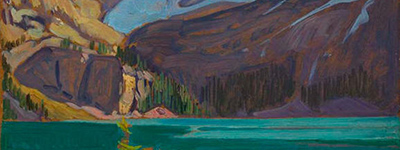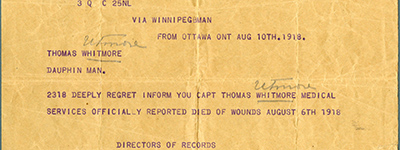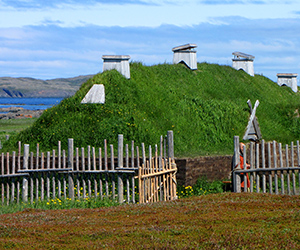CANADA HISTORY - Places-Archeological
Drumheller

The Royal Tyrrell Museum of Palaeontology, located in Drumheller, Alberta, is one of the world’s premier centers for the study of ancient life, particularly dinosaurs, and a crown jewel in Canada’s scientific and cultural heritage. Nestled in the heart of Alberta’s Badlands—a region globally recognized for its rich fossil deposits—the museum is both a leading research institution and a major tourist destination, drawing visitors from around the world. The museum’s origins, its exhibits, and its contributions to science and education make it a vital part of Canada’s relationship with its prehistoric past.
Origins and Naming
The museum takes its name from Joseph Burr Tyrrell, a geologist whose work in the late 19th century was pivotal to the discovery of Alberta’s fossil treasures. In 1884, while surveying for coal deposits in the Red Deer River Valley, Tyrrell stumbled upon the skull of a large carnivorous dinosaur, later identified as Albertosaurus. This discovery marked the beginning of an era in which the region’s fossil beds would become famous for yielding some of the world’s most important dinosaur specimens. By honoring Tyrrell in its name, the museum acknowledges his role in opening up this vast prehistoric world to scientific exploration.
The idea for a museum dedicated to Alberta’s rich fossil heritage took root in the early 1980s. Recognizing the need to showcase the province’s wealth of fossil discoveries and the growing global interest in dinosaurs, the Alberta provincial government initiated the project. The goal was not only to create a world-class museum but also to establish a research institution that would contribute to the field of paleontology on a global scale. Construction of the museum began in the early 1980s, and on September 25, 1985, the Royal Tyrrell Museum officially opened its doors to the public.
The Facility and Its Highlights
The Royal Tyrrell Museum’s facility has grown and evolved since its opening, becoming a leader in both paleontological research and public education. The museum’s vast collection includes over 130,000 fossils, many of which are on display in the museum’s extensive galleries. The Dinosaur Hall is one of the most iconic exhibits, featuring life-sized reconstructions and fossilized skeletons of some of the most famous dinosaurs, including Tyrannosaurus rex, Triceratops, Stegosaurus, and Albertosaurus. These exhibits allow visitors to stand face-to-face with these ancient giants, offering a glimpse into a world that existed millions of years ago.
One of the museum's most significant exhibits is the Burgess Shale exhibit, which displays fossils from the Burgess Shale, one of the most important fossil sites in the world. Located in the Canadian Rockies, the Burgess Shale contains exceptionally well-preserved fossils from over 500 million years ago, representing a time known as the Cambrian Explosion, when most major groups of animals first appeared. This exhibit helps visitors understand the origins of complex life on Earth, connecting Alberta’s prehistoric heritage with the broader story of life on the planet.
The Royal Tyrrell Museum is also home to one of the most active paleontological research teams in the world. Every year, the museum’s scientists engage in fieldwork across Alberta’s Badlands and beyond, uncovering new fossils that help deepen our understanding of prehistoric life. The museum’s laboratories are equipped with state-of-the-art technology that allows paleontologists to study fossils in detail, using advanced imaging techniques and 3D modeling to reconstruct ancient ecosystems. Many of the discoveries made by the museum’s team have contributed to significant breakthroughs in the field, including the discovery of new dinosaur species.
Educational Programs and Outreach
Beyond its exhibits, the Royal Tyrrell Museum has become a central hub for public education about paleontology. The museum’s educational programs are designed to inspire curiosity and foster a deeper understanding of the natural world. School groups from across Canada regularly visit the museum, where they participate in hands-on activities such as fossil casting, simulated fossil digs, and workshops that teach the methods paleontologists use in the field. These programs encourage young Canadians to explore careers in science and contribute to a broader appreciation of Canada’s rich natural history.
The museum also engages in extensive outreach efforts, bringing the excitement of paleontology to communities across Canada and the world. Through virtual tours, educational videos, and online resources, the Royal Tyrrell Museum reaches audiences who cannot visit in person, ensuring that its wealth of knowledge is accessible to all. These initiatives have made the museum a global leader in paleontological education and outreach, further solidifying its impact on the public’s understanding of ancient life.
Impact on Canada and Canadians
The Royal Tyrrell Museum’s significance extends beyond its status as a scientific institution. For Canada, the museum is a source of national pride, representing the country’s unique contribution to the global understanding of prehistoric life. Alberta’s Badlands are one of the richest fossil regions on Earth, and the museum’s role in studying and preserving these fossils highlights Canada’s leadership in the field of paleontology.
For Canadians, the museum is more than just a tourist attraction—it is a vital link to the country’s natural heritage. The museum’s exhibits and educational programs allow Canadians to engage with their history in a way that is both exciting and informative. By bringing the prehistoric world to life, the Royal Tyrrell Museum fosters a sense of wonder and curiosity that connects Canadians to the distant past.
The museum has also had a significant economic impact on the region. Drumheller, once a coal-mining town, has transformed into a global hub for paleontology, largely due to the presence of the Royal Tyrrell Museum. The influx of visitors has revitalized the local economy, creating jobs and boosting tourism. The museum attracts hundreds of thousands of visitors each year, making it one of Alberta’s top tourist destinations. This economic benefit extends beyond Drumheller, as the museum draws international attention to Canada’s natural beauty and scientific achievements.
The Royal Tyrrell Museum of Palaeontology is a remarkable institution that blends scientific discovery with public education. Its origins in Alberta’s Badlands, one of the richest fossil-bearing regions in the world, give it a unique place in the global paleontological community. Named after the pioneering geologist Joseph Burr Tyrrell, the museum has become a center for cutting-edge research, world-class exhibits, and educational outreach that impacts visitors from Canada and beyond.
For Canadians, the museum serves as a vital connection to the prehistoric past, showcasing the country's rich natural history and inspiring new generations to explore the wonders of science. Its economic impact on Drumheller and the surrounding region further underscores its importance to Canada. Ultimately, the Royal Tyrrell Museum stands as a testament to the power of discovery, education, and the enduring fascination with the ancient world.
Cite Article : Reference: www.canadahistory.com/sections/documents/documents.html
Source: NA



